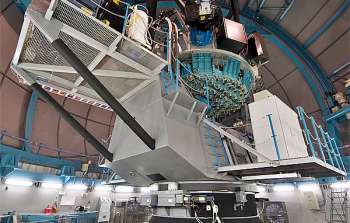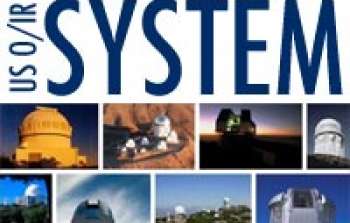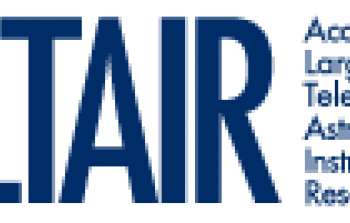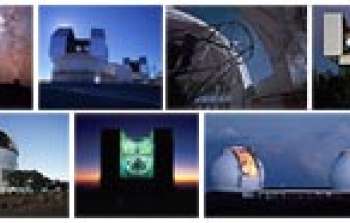sci09001 — Announcement
NOAO in 2009: Opportunities, Challenges, and the Decadal Survey David Silva
January 31, 2009
The NOAO Town Hall held during the January AAS meeting generated a lively discussion regarding the opportunities and challenges ahead for the ground-based optical/infrared community. In this article, I highlight the major near-term issues that we discussed. Your input is welcome on any of these issues. Please send your thoughts to currents@noao.edu.
- New Instruments for 4m-Class Telescopes
- Developing the US O/IR System of Observing Resources
- ALTAIR Findings and Preliminary Recommendations
- The Astro2010 Decadal Survey — Stay the Course
New Instruments for 4m-Class Telescopes
New opportunities are available, and other significant improvements are underway, in our optical and infrared imaging capability at Kitt Peak, Cerro Tololo, and Cerro Pachon.
NEWFIRM (NOAO Extremely Wide-Field Infrared Imager), a big success on the Mayall, delivers a 28’ × 28’ field of view (FOV) with 0.4” pixels at 1-2.4 microns. NEWFIRM will move to the Blanco 4-m telescope in the 2010 – 2012 time frame, depending on the DECam installation schedule (see below).
WHIRC (WIYN High-Resolution Infrared Camera) frequently demonstrates seeing-limited performance of 0.5”-0.6” FWHM. When used with the WIYN Tip-Tilt Module, WHIRC should deliver 0.3” FWHM images in the Ks-band under typical conditions and diffraction-limited 0.15” FWHM images on exceptional nights.
The Goodman Imaging Spectrograph is currently available at SOAR in long-slit and imaging modes. It uses high-throughput VPH gratings and delivers 20-30% overall peak system efficiency. It will eventually be capable of multi-object spectroscopy over a 3’ × 5’ FOV using slit masks. (See also the upcoming issue of the NOAO Newsletter for further details).
Spartan, a high angular resolution NIR camera, is being commissioned at SOAR, and will replace OSIRIS for imaging when it becomes fully available. Supplementary calls for science verification proposals may be made later this year to help commission Spartan or additional modes of the Goodman Spectrograph.
SAM (SOAR Adaptive Optics Module) will provide enhanced image quality (0.2”-0.3” FWHM) at optical wavelengths over a 3’ field by correcting for ground-layer atmospheric turbulence. It will be deployed in natural guide star mode in mid-2009 and with full laser deployment in 2010.
DECam (Dark Energy Camera) will begin science operations in 2011. Featuring a 2-degree diameter FOV and an extremely red-sensitive 500 Megapixel camera, it will replace the MOSAIC imager on the Blanco 4-m telescope.
ODI (One Degree Imager) is scheduled to arrive at WIYN in early 2010. Orthogonal transfer array CCDs will actively correct images for tip-tilt image motion over the entire field of view, producing 0.4” FWHM images over a 1-degree field.
Developing the US O/IR System of Observing Resources
The fundamental element of the NOAO mission is to develop and deliver community access to an optimized suite of high-performance telescopes of all apertures. This vision of the NOAO mission was endorsed by both the 2000 Astronomy and Astrophysics Decadal Survey and the 2006 NSF Division of Astronomical Sciences Senior Review. To enable the development of such a “System” of resources, the Senior Review gave NOAO a strong endorsement to rebuild and revitalize NOAO and other System facilities at the 4m-class level. It also supported paced growth by NOAO in support of GSMT and LSST. The NSF further asked NOAO to assume a leadership role in a phased and multi-faceted national GSMT program, organizing and representing community input and participation, and effectively acting as the NSF’s agent in managing the overall program.
As described in previous issues of Currents, we have moved ahead quickly toward these goals, convening in 2007 a community-based committee to review the portfolio of System resources in the 2- to 5-m aperture range (the ReSTAR committee), and then submitting in 2008 a proposal to the NSF for supplementary funding to implement the highest priority committee recommendations. Similarly, NOAO convened in 2008 the community-based ALTAIR committee to evaluate the larger aperture (6.5 to 10 meter) end of the optical/infrared (O/IR) System. The committee report is expected later this month, and its preliminary recommendations are described below.
ALTAIR Findings and Preliminary Recommendations
Through its survey of the NOAO community, the ALTAIR committee has found that (i) there is a large, energized user community of 6.5- to 10-m telescopes; (ii) demand for observing time on such large telescopes exceeds access by a factor of more than 3 to 4; (iii) there is significant community dissatisfaction with the Gemini Observatory; and (iv) there is significant demand for missing capabilities in the large telescope open access system, in particular “workhorse” spectroscopic and wide-field imaging capabilities.
Based on these findings, the ALTAIR committee has developed preliminary recommendations that include the following. The committee
- endorses the need for a system of large telescopes comprised of federal and non-federal facilities;
- recommends that NSF increase the funding, to $10M per year, for an NOAO-led TSIP or TSIP-like program in order to increase the open access time available on non-federal facilities (the current TSIP budget is approximately $4M per year);
- recommends that the NSF increase US participation in the Gemini Observatory, but only if Gemini becomes more responsive to the US community and evolves to a suite of instrumentation, operations modes, and other services that are well aligned with the needs of the US community;
- recommends that NOAO develop and maintain a roadmap for the development of the large telescope system based on regular input from the US community, and that NOAO be an active advocate for the development of the large telescope system, using tools such as TSIP funding, input to the Gemini Board, and other methods (e.g., time trades) to achieve a balance of public access capabilities that is aligned with the research goals of the US community.
The Astro2010 Decadal Survey — Stay the Course
This brings us to the current Astronomy and Astrophysics Decadal Survey, Astro2010, the latest in a series of surveys that are produced each decade by the National Research Council (NRC) of The National Academy of Sciences. Successes from the 2000 Decadal Survey (Astronomy and Astrophysics in the New Millennium) include the Telescope System Instrumentation Program (TSIP) and progress toward LSST and GSMT. The charge of Astro2010 is to recommend priorities for the most important scientific and technical ground- and space-based activities of the 2010-2020 decade. The activities to be discussed are likely to include GSMT, LSST, the development of the US O/IR System, and the role of NOAO in all of these activities.
A potential danger is that Astro2010 may propose changes to the NOAO mission that are in conflict with the course set for us by the 2000 Decadal Survey and the 2006 NSF AST Senior Review. As described above, the fundamental element of our mission is to deliver community access to an optimized system of high-performance telescopes of all apertures. As further noted by the Senior Review, “For the past few decades, NOAO…has received variable directions from the community and NSF that has made planning difficult.” To avoid such a course change with the current decadal survey, we aim to present, as input to Astro2010, a clear picture of our current program and future plans that are both consistent with and build on the recommendations of the 2000 Decadal Survey and the 2006 NSF AST Senior Review.
Here are some of the channels by which NOAO and AURA will provide input to Astro2010 on behalf of the US ground-based O/IR community. Please contact us at currents@noao.edu with your views on the input we can provide to best strengthen the US ground-based O/IR System.
AURA has appointed the Future of NOAO within the System Committee, led by Tim Beers (Michigan State University), to assist NOAO in developing a strategic vision for its role within the US O/IR System over the next decade. The committee will review the role of NOAO in activities such as elements of system development recommended by the NSF AST Senior Review, interfaces with Gemini and LSST, and with future Extremely Large Telescopes. The committee membership and draft charge are available at the committee Web site. Important starting points include recommendations from the NOAO Users, ReSTAR, and ALTAIR committees. The committee will also remain cognizant of existing LSST and GSMT plans and schedules. The first committee meeting was held immediately after the January AAS meeting. Further developments will be reported in future issues of Currents and in the NOAO Newsletter.
NOAO has commissioned the GSMT Community Assessment Panel in coordination with the NSF. Led by Dr. Tony Beasley, project manager of the National Ecological Observatory Network (NEON), this independent panel will assess the status of the Giant Magellan Telescope (GMT) and Thirty Meter Telescope (TMT) projects. The panel is not charged with comparing the projects but only with assessing the current status of each project in terms of elements such as schedule credibility and estimated total lifecycle cost, as well as current progress towards construction readiness. Separate reports on each project will be generated and delivered to NOAO for transmission to the NSF and Astro2010. Further discussion of this community assessment will appear in a future issue of Currents and in the NOAO Newsletter.
Contacts
currents@noao.edu
About the Announcement
| Id: |
ID
sci09001
|



